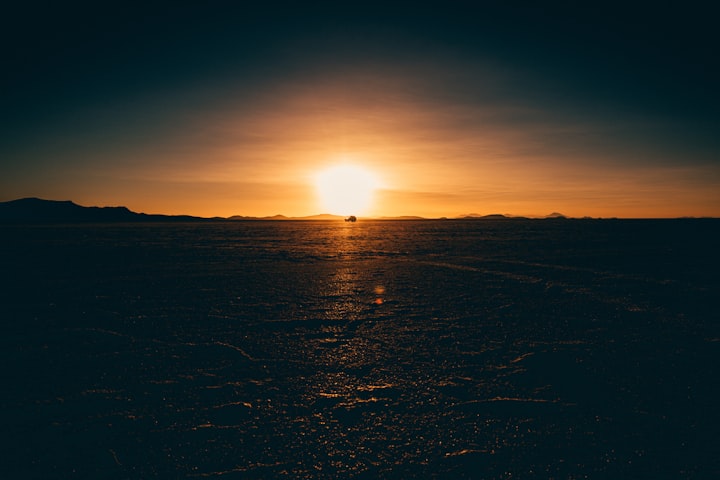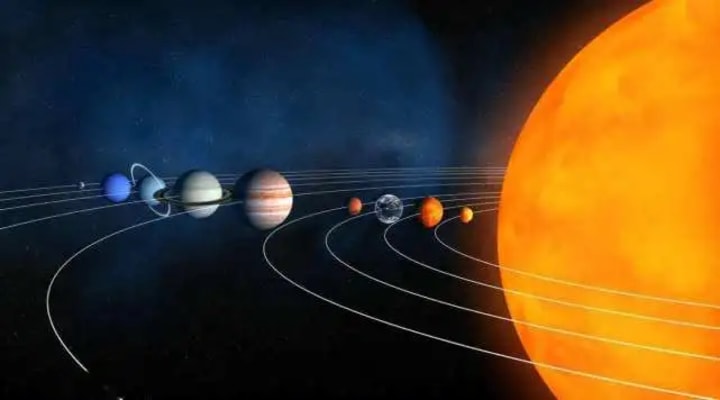The sun's gravity is so strong, why won't the eight planets be sucked over and then hit the surface of the sun?
The Sun and the eight planets

Why do the eight planets revolve around the sun instead of flying directly towards it? Wasn't it agreed that the gravitational force of the Sun is very strong?
In the history of the solar system, there were many planets, but in the end only eight planets remained, why?
We may have a misunderstanding of gravity, thinking that it is simply an attractive force, but in fact, every matter in the universe is in motion, and the process of motion also generates momentum.
The reason why the planets' orbit around the sun, instead of being attracted straight to the sun and crashing into it, is a balanced relationship.

Gravity
One reason for the Sun's enormous gravitational pull is that the Sun's mass is simply too large. According to Lord Bull's axiom of gravity, to escape the Sun's gravitational bindings, an object must reach 16.7 km/s so that it can escape the solar system.
No planet has reached this standard of speed, so they can only orbit the sun.
But the question arises, humans jump a little jump can not jump to the Earth because of the Earth's gravity, why the Earth will not be sucked directly by the Sun over?
The initial solar system was chaotic and disorderly, because the sun was not fully formed and the gravitational force was weak during this period.
The planets were born with momentum and they moved haphazardly within the solar system, also colliding badly with each other because of the gravitational force, and it was at this time that the moon was knocked out.
As the sun matured, it began to write a new order, which was that all the planets were subject to its control.
This control is a balance, because these bodies have a primitive initial velocity, and after being subjected to the Sun's gravitational force, 3 situations occur.
In the first case, the object flies towards the Sun under the effect of gravity. The speed of this object is so slow that the inertia generated by the initial velocity cannot balance with the Sun's gravity, so it is attracted to crash directly into the Sun.
In the second case, far from the Sun, this object is moving very fast, greater than 16.7 km/s, and its centrifugal inertia is greater than the Sun's gravity.
In the third case, they are moving around the Sun, and their inertia of motion is gradually balanced with the Sun's gravity, so that they are neither attracted nor flying away.
This class of objects are our eight planets, asteroids, dwarf planets, and comets today.

After the sun was sorted out and a new order of the solar system was born, most of the stars needed to orbit around it, and bodies like moons orbited the planets.
This process lasted for about several hundred million years, and the eight planets gradually lost their initial unruliness and began to arrange themselves in an orderly fashion.
In a word, the planets have a tendency to escape from the Sun, but this centrifugal force does not suppress the Sun's gravitational force, but rather balances with it.
This is why the more distant the object from the Sun, the longer its period and the slower its rotation, with the fastest Mercury rotating 8.8 times faster than the slowest Neptune.
The slowest Neptune
If Neptune gets faster one day, it will not be far from flying out of the solar system.
This applies not only to the Sun, but also to the relationship between the Earth and the Moon, which itself has a tendency to escape from the Earth, and is currently in balance between the two.
However, the Moon is moving away from the Earth at a speed of 3.8 cm, which indicates that the balance between the two is gradually being broken.
So, will the eight planets also move away from the Sun?
Order makers
In fact, the eight planets are also moving away from the Sun because the Sun is "losing weight".
The speed of the sun is simply frightening, it can lose 4.2 million tons of weight in a second, and the mass lost in a day is equivalent to a hair on the head of a human being.
When people are losing weight, they will be glad that they lost a hair and thin? Not really, so this mass for the sun that is simply a hair.
However, to say that this mass has no effect at all is not very realistic, because this mass will have a subtle effect on the sun's gravity, that is, the gravitational pull is weakened.
But this weakening does not affect the balance between the Sun's gravity and the centrifugal inertia of the eight planets, which are slowly moving away, not flying away in a flash.
In fact, the distance between the Sun and the eight planets has been expanding, and a number of scientists believe that the planet that first stayed in the habitable zone was not Earth, but Mars.
Mars is thought to have been the first to see life because at the beginning of the solar system, the Earth was closer to the Sun than it is today, plus the Earth's atmosphere was not fully formed at that time and the planet was not habitable for life.
On the contrary, Mars, even with its thin atmosphere, could have nurtured life in the habitable zone, and they speculate that life emerged on Mars hundreds of millions of years earlier than on Earth.
However, as the Sun's nuclear fusion proceeded, Mars moved further and further away from the Sun, gradually leaving the habitable zone, and instead the Earth came within the habitable zone.
As a result, Mars was unable to produce a greenhouse effect because of its thin atmosphere, causing its temperature to drop all the way down, coupled with the decomposition of water on the surface into gas under the action of solar radiation.
Eventually it became a cold, arid, desolate red planet, and Earth became the planet in the solar system with an exclusive habitable zone.
As the Sun's mass decreases between, the Earth will gradually move away from the Sun, but there is no need to worry about the Earth cooling, because this process of moving away usually lasts hundreds of millions of years or more.
Leaving the solar system
As mentioned earlier, according to Newton's formula for gravity, the speed of leaving the Sun must reach 16.7 km/s. At present, no natural object in the solar system has reached this speed, because the ones that have reached this speed are long gone from the solar system.
However, there are two man-made machines that have exceeded this speed and are traveling to the outer solar system, and they are both Voyager series probes 1 and 2.
However, these two Voyagers did not launch at this value, and they cleverly used the gravitational force of Jupiter to accelerate themselves to the speed required to leave the solar system.
Jupiter, the top of the eight planets in both mass and volume, covered the Earth like a big brother, and it used its gravity to successfully change the trajectory of several asteroids and comets, allowing the Earth to escape from being hit.
Jupiter's gravity is the second largest celestial body after the Sun, so it inevitably affects other planets, such as Mars, according to the original law, the mass of Mars will be more than the Earth, but Jupiter here to influence, resulting in Mars in the initial nebula disk did not grab any material inside.
This is like a family with eight children eating, originally Mars can eat four bowls of rice, because it is blocked by Jupiter, and as a result it only eats one bowl of rice.

Similarly, Mercury is so close to the Sun, yet it still rotates well, thanks to its super-fast speed, which keeps its inertia in balance with the Sun's gravity.
Perhaps once Mercury was not the closest planet to the Sun, except that the ones closer than it were really swallowed up by the Sun.
The Sun does not use its gravity to destroy the planets, but rather to arrange the pattern in a way that if it cannot balance with it, it is either swallowed by the Sun or abandoned by it.
So the eight planets are in orbit by virtue of their own ability, and all of them are planets with two tricks up their sleeves.
The balance is broken
The Sun's mass is decreasing, but the Sun's size is increasing. When the Sun has spent its last 5 billion years, it will start to expand and become a "big fat guy".
This big fat guy is called a red giant, and it will be more than 100 times bigger than the Sun today, expanding all the way to eat the first four planets and approaching the orbit of Jupiter.
At this time, the gravitational equilibrium is not actually broken, but the red giant's expansion is unreasonable, and it will eat whoever it meets.
Therefore, the solar system will fall apart at this time, and with the final collapse, the once well-organized solar system will once again return to its previous chaos, becoming a nebula waiting for the next star to be born.
As for the Sun, it became a small white star - a white dwarf, still surrounded by one or two objects, but long ago, without the prosperity of the original solar system.

This is the law of the universe, decay brings new life, new life to decay, the universe is so more than 14 billion years of turnover, the sun is just one of them.
About the Creator
Richard Shurwood
If you wish to succeed, you should use persistence as your good friend, experience as your reference, prudence as your brother and hope as your sentry.






Comments (1)
Gravity is incredible, it can be so flat and stable and precise, more accurate than the clocks invented by man.